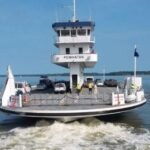Scotland’s road network isn’t just tarmac and traffic—it’s a sprawling, aging, often stubborn web of over 5,000 structures that quite literally hold the country together. And as Hazel McDonald puts it, keeping them standing is anything but straightforward.
McDonald, the chief bridge engineer at Transport Scotland, is responsible for one of the most thankless yet crucial jobs in the nation’s infrastructure ecosystem. Her team looks after everything from culverts and gantries to high masts, retaining walls, and the 2,070 bridges that dot the national trunk road network.
“We’re basically working with infrastructure that’s showing its age,” she says, without sugarcoating. “And replacing even one bridge? It’s often twice the job you think it is.”
Why Bridges Take Twice the Work You’d Expect
Let’s say you’ve got a bridge that’s ready for replacement. Simple, right? Just swap it out.
Not so fast.
In remote parts of Scotland—especially in rural areas or on island routes—there’s often no backup road. No handy detour. Which means you can’t just close the bridge and call it a day. You need something temporary to keep traffic flowing while the main job happens.
“That means designing and building not one, but two bridges,” McDonald explains. “You’ve got your permanent replacement, sure. But also a temporary bridge. You’re doing twice the design work, twice the foundations, and all the environmental assessments. And then, when you’re done, you’ve got to restore the site.”
She pauses, then adds, “And that’s assuming we even own the land. Often, we don’t.”

Negotiating with Landowners, Councils, and Everyone in Between
McDonald’s job doesn’t stop at engineering. It’s part negotiation, part politics, and part rural diplomacy.
Much of Scotland’s trunk road infrastructure runs through land the government doesn’t actually own. So before anything happens, there’s a maze of legalities—land negotiations, consultations, purchase agreements. That alone can stall projects for months. Sometimes years.
“You’re not just dealing with one landowner,” she says. “There are farmers, smallholders, estate managers. And they all have questions. Fair enough. But it’s slow going.”
Then there’s the list of people Transport Scotland must keep in the loop:
-
Local councillors
-
MSPs and MPs
-
Business owners impacted by construction
-
Tourism boards
-
Environmental groups
Each with different concerns. And none of them can be ignored.
Roadworks vs. the Tourist Rush
Timing? Also a nightmare.
In areas where tourism drives the local economy—think Skye, the Highlands, and coastal routes—shutting roads during peak months is a non-starter.
“You can’t just show up in June and close a bridge,” McDonald says. “That could kill the season for local businesses.”
So work has to be timed carefully. Spring or autumn, if you’re lucky. Winter, if you’re not.
Which is why even urgent repairs sometimes wait—not because engineers are slow, but because shutting a single rural bridge in July could cost a town its entire summer.
What the Numbers Look Like
Just to get a sense of scale, here’s how the structures on Scotland’s trunk roads break down:
| Structure Type | Count |
|---|---|
| Bridges | 2,070 |
| Culverts | 669 |
| Footbridges | 154 |
| High Masts | 763 |
| Retaining Walls | 977 |
| Gantries | 484 |
| Large Signs | 258 |
That’s a lot of aging infrastructure to maintain—most of which was built before smartphones, let alone climate risk models.
New Inspection Tech Could Change the Game (Maybe)
McDonald sees opportunity in tech, but she’s cautious about overpromising.
Drones, AI scanning, remote sensors—they’re all being explored. But using them at scale? That’s another story.
“We are trying to identify where new inspection methods can help,” she says. “Drones have helped with hard-to-reach structures. But a lot of what we do still needs boots on the ground.”
Even where high-tech tools are useful, they still need to be backed by physical assessments, especially when structural safety is on the line.
She adds, “Tech can flag issues. But only a trained engineer can say, ‘Yes, this is serious.’”
The Job Nobody Notices—Until Something Fails
One of the biggest frustrations? Most people never think about the bridge they just drove over—until it fails.
“There’s no ribbon-cutting for maintenance,” McDonald says with a half-smile. “People notice potholes, but they don’t see a parapet that’s cracking. Or a joint that’s rusted. That’s our job: to fix it before it’s a headline.”
That includes inspections in wild weather. Overnight closures to weld a failing girder. Sudden storm damage that needs a crew at 2 a.m. And the constant pressure of working beneath the public radar.
One mistake, though, and it’s front page news.
Why She Still Loves the Work
Despite all that, McDonald is clearly committed. She talks about bridges like living things. You get the sense she’s proud of them—especially the older ones. The battered veterans of the network.
“There’s something satisfying,” she says. “Knowing you kept a structure safe, that no one even noticed it needed help.”
She looks out her office window, where a grey sky’s been threatening rain all morning. “We don’t get medals. But we keep Scotland moving.”


















